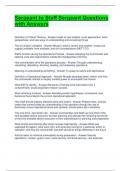Sergeant to Staff Sergeant Questions
with Answers
Definition of Critical Thinking - Answer-Leads to new insights, novel approaches, fresh
perspectives, and new ways of understanding and conceiving things
The six mission variables - Answer-Mission, enemy, terrain and weather, troops and
support available, time available, and civil considerations (METT-TC)
Staff's function during the Operations Process - Answer-Assisting the Commander and
keeping units and organizations outside the headquarters informed
How commanders drive the operations process - Answer-Through understanding,
visualizing, describing, directing, leading, and assessing operations
Meaning of understanding something - Answer-To grasp its nature and significance
Definition of Operational Approach - Answer-Broadly describes when, where, and how
the commander intends to employ combat power to accomplish the mission
What EEFI's identify - Answer-Elements of friendly force information that, if
compromised, would jeopardize mission success
What reframing involves - Answer-Revisiting earlier hypotheses, conclusions, and
decisions that underpin the current operational approach
How Staff should prepare effective plans and orders - Answer-Prepare clear, concise
orders that communicate an understanding of the operation through the use of
doctrinally correct operational terms and symbols; shorter plans aid in simplicity
The 'one-third—two-thirds rule' - Answer-Commanders and Staff use one-third of the
time available before execution for their planning and allocate the remaining two-thirds
of the time available before execution to their subordinates for planning and preparation
What formal and informal after action reviews help identify - Answer-What was
supposed to happen, what went right, and what went wrong for a particular action or
operation, and how the commander and staff should do things differently in the future
Actions taken to minimize vulnerability during preparation - Answer-Security
operations—screen, guard, cover, area security, and local security—are essential
, Gun salute for a President or Former President of the U.S. when arriving and leaving an
army installation - Answer-21 gun salute
Instances when you salute inside a building - Answer-When reporting to your
commander, when reporting to a pay officer, when reporting to a military board, at an
indoor ceremony, at sentry duty indoors
Examples of when enlisted members would exchange salutes - Answer-When rendering
reports in formation, when reporting to an enlisted president of a board
Origin of the Salute - Answer-Uncertain, possibly began in late Roman times as a way
of showing respect and gradually involved removing the hat, modified to touching the
hat by 1820
Standard Form (SF) for Security Container Check Sheet - Answer-SF 702
AR that covers security - Answer-AR 380-5
Frequency of Challenge and Password change - Answer-Every 24 hours
Purpose of Challenge and Password - Answer-To identify unknown personnel
Definition of OPSEC - Answer-Program within the unit to deny a potential enemy
information on the brigade's intentions, plans, and operations
Meaning of SALUTE - Answer-Size, Activity, Location, Uniform, Time, Equipment
Definition of OPSEC - Answer-Operational Security
Groups in which prisoners of war should be divided - Answer-Officers, NCOs, Privates,
Deserters, Females, Civilians, Political Personnel
The 5 S's that apply to POWs - Answer-Search, Segregate, Silence, Speed, Safeguard
Meaning of MIJI - Answer-Meaconing, Intrusion, Jamming, and Interference
Access to secret material for a person with Secret clearance - Answer-Granted on a
need to know basis
Meaning of SAEDA - Answer-Subversion And Espionage Directed against the Army
Counterintelligence measures - Answer-Use of sign and countersign, Camouflage,
Recon, Noise and light discipline, OPSEC training
Number of overall security classifications a document can have - Answer-1




